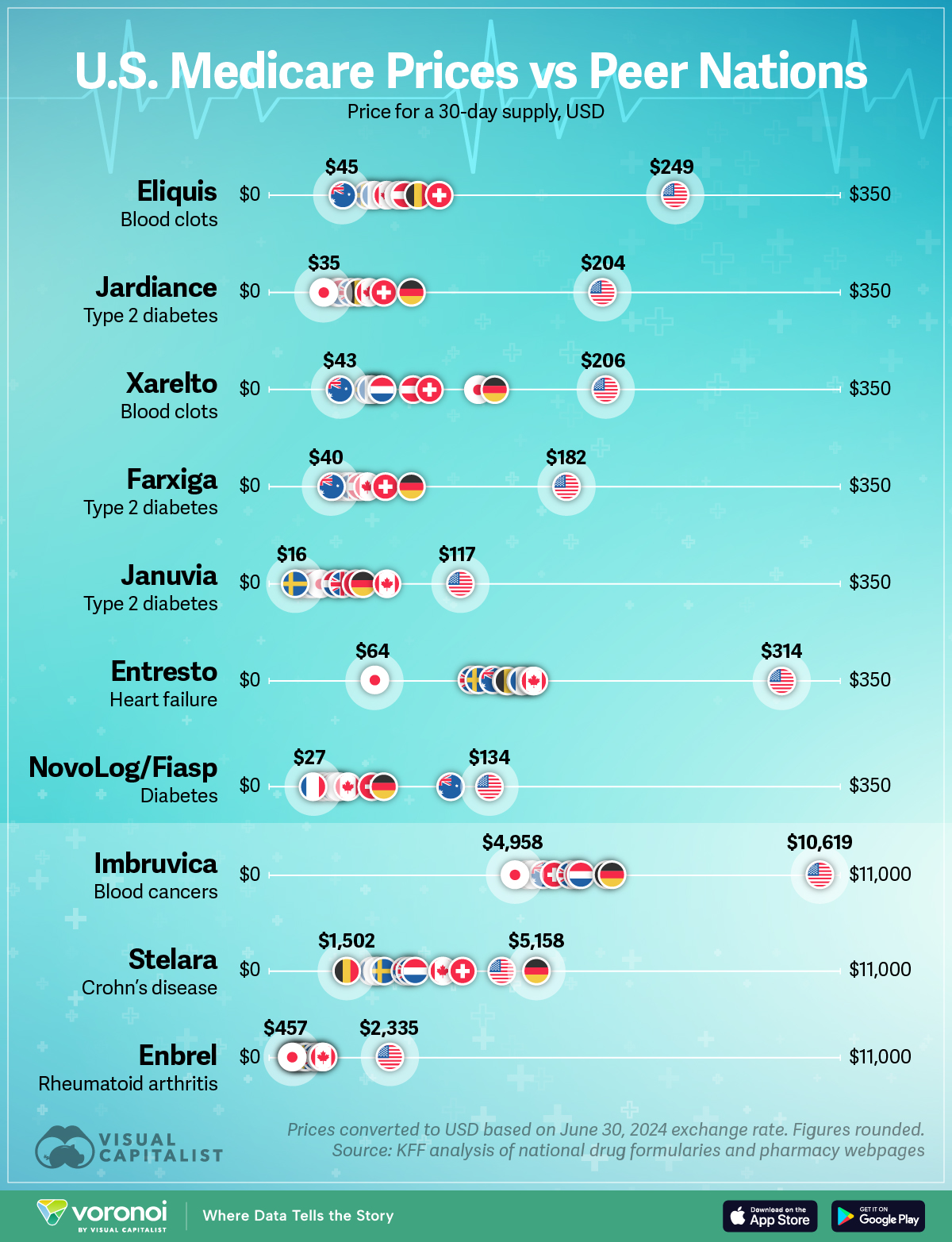How U.S. Medicare Prices Compare to Other Rich Nations
This was originally posted on our Voronoi app. Download the app for free on iOS or Android and discover incredible data-driven charts from a variety of trusted sources.
Key Takeaways
- Medicare-negotiated drug prices in the U.S. are much higher than those in other rich nations, with the exception of Stelara in Germany
- The peer group in this analysis includes: Australia, Austria, Belgium, Canada, France, Germany, Japan, Netherlands, Sweden, Switzerland, and the UK
Medicare, the U.S. government’s health insurance program primarily for seniors, covers nearly 65 million Americans—but at what cost?
Despite its massive scale, Medicare often pays significantly more for prescription drugs than health systems in other rich nations. In this infographic, we compare the prices for a 30-day supply of 10 prominent drugs using data from Peterson-KFF.
Data & Discussion
A provision in the Inflation Reduction Act of 2022 required Medicare to negotiate prices with pharmaceutical companies for 10 high-expenditure drugs that lack generic competition.
The Medicare prices shown in this graphic were published on Aug. 15, 2024, and will go into effect for Medicare enrollees on Jan. 1, 2026.
Data for the first seven drugs in this graphic ($0 to $350 scale) are listed below:
| Country | Eliquis | Jardiance | Xarelto | Farxiga | Januvia | Entresto | NovoLog/Fiasp |
|---|---|---|---|---|---|---|---|
 U.S. U.S. |
$249 | $204 | $206 | $182 | $117 | $314 | $134 |
 Switzerland Switzerland |
$104 | $70 | $98 | $71 | $53 | $155 | $63 |
 Germany Germany |
$91 | $87 | $138 | $87 | $57 | $154 | $70 |
 Belgium Belgium |
$91 | $54 | – | $54 | $24 | $146 | $33 |
 Austria Austria |
$83 | $50 | $88 | $55 | – | $161 | $45 |
 Japan Japan |
$79 | $35 | $128 | $47 | $31 | $64 | $43 |
 Netherlands Netherlands |
$72 | $45 | $69 | $47 | $40 | $145 | $38 |
 UK UK |
$72 | $50 | $68 | $50 | $45 | $124 | $41 |
 Canada Canada |
$72 | $61 | $63 | $60 | $72 | $162 | $48 |
 France France |
$64 | $42 | $62 | $42 | $20 | $155 | $27 |
 Sweden Sweden |
$60 | $43 | $60 | $43 | $16 | $128 | $31 |
 Australia Australia |
$45 | $41 | $43 | $40 | $27 | $137 | $111 |
 Peer Average Peer Average |
$76 | $52 | $82 | $54 | $39 | $139 | $50 |
Within this group, drugs with the largest Medicare price premium are:
- Jardiance (Diabetes): +289%
- Farxiga (Diabetes): +236%
- Eliquis (Blood thinner): +228%
Finally, data for the last three drugs ($0 to $11,000 scale) are listed below:
| Country | Enbrel | Imbruvica | Stelara |
|---|---|---|---|
 U.S. U.S. |
$2,335 | $10,619 | $4,490 |
 Switzerland Switzerland |
$1,021 | $5,500 | $3,734 |
 Germany Germany |
$1,003 | $6,615 | $5,158 |
 Belgium Belgium |
$496 | $6,515 | $1,502 |
 Austria Austria |
$660 | $5,655 | $2,827 |
 Japan Japan |
$457 | $4,958 | $2,092 |
 Netherlands Netherlands |
$690 | $6,010 | $2,830 |
 UK UK |
$904 | $5,814 | $2,714 |
 Canada Canada |
$1,049 | $5,955 | $3,353 |
 France France |
$517 | $5,082 | $1,987 |
 Sweden Sweden |
$718 | $4,974 | $2,222 |
 Australia Australia |
$563 | $5,292 | $2,624 |
 Peer Average Peer Average |
$734 | $5,670 | $2,822 |
The Medicare-negotiated price for Enbrel is +218% higher than the average peer group price, while Imbruvica and Stelara have a smaller premium (+87% and +59% respectively).
Who Makes These Drugs?
The 10 drugs included in this analysis come from a variety of pharmaceutical companies, though most are produced by U.S. firms.
| Drug | Manufacturer |
|---|---|
| Eliquis |  Bristol-Myers Squibb Bristol-Myers Squibb |
| Jardiance |  Boehringer Ingelheim Boehringer Ingelheim Eli Lilly Eli Lilly |
| Xarelto |  Janssen (Johnson & Johnson) Janssen (Johnson & Johnson) |
| Farxiga |  AstraZeneca AstraZeneca |
| Januvia |  Merck & Co. Merck & Co. |
| Entresto |  Novartis Novartis |
| NovoLog / Fiasp |  Novo Nordisk Novo Nordisk |
| Imbruvica |  Janssen (Johnson & Johnson) Janssen (Johnson & Johnson) Pharmacyclics (AbbVie) Pharmacyclics (AbbVie) |
| Stelara |  Janssen (Johnson & Johnson) Janssen (Johnson & Johnson) |
| Enbrel |  Amgen Amgen |
Why Are U.S. Prices So Much Higher?
Peterson-KFF outlines several factors for why Americans often pay more for their drugs.
For starters, Medicare “exists in the context of a fragmented system of multiple payers, including commercial insurers who negotiate their own drug prices.” In many of the peer group countries, governments are more involved in setting universal drug prices.
Second is the absence of generic or biosimilar medications available in the United States. The introduction of generics typically reduces the prices of brand-name drugs due to increased competition.
For 8 out of the 10 drugs included in this analysis, there was at least one peer group country that offered a generic alternative.
Differences in U.S. and international patent laws, as well as differences in the regulatory groups that approve medications for public use, help to account for why generics may be available in other countries but not the United States.
Finally, there are key differences in how Medicare negotiates prices with manufacturers.
Medicare evaluates the costs to manufacturers to research, develop, and produce the drug when setting prices (something only 2 of the 11 peer group countries consider).
The alternative would be value-based pricing, which evaluates the effectiveness of a drug instead. Furthermore, Medicare does not consider drug prices in other countries when negotiating its own prices, a practice that 8 of the 11 peer group countries employ.
Learn More on the Voronoi App 
If you enjoyed today’s post, check out this graphic on Life Expectancy At Birth, which compares the U.S. to the same 11 country peer group.

